SQL to JSON Data Modeling with Hackolade
Review: SQL to JSON data modeling
First, let’s review, the main way to represent relations in a relational database is via a key/foreign key relationship between tables.
When looking at modeling in JSON, there are two main ways to represent relationships:
Referential - Concepts are given their own documents, but reference other document(s) using document keys.
Denormalization - Instead of splitting data between documents using keys, group the concepts into a single document.
I started with a relational model of shopping carts and social media users.
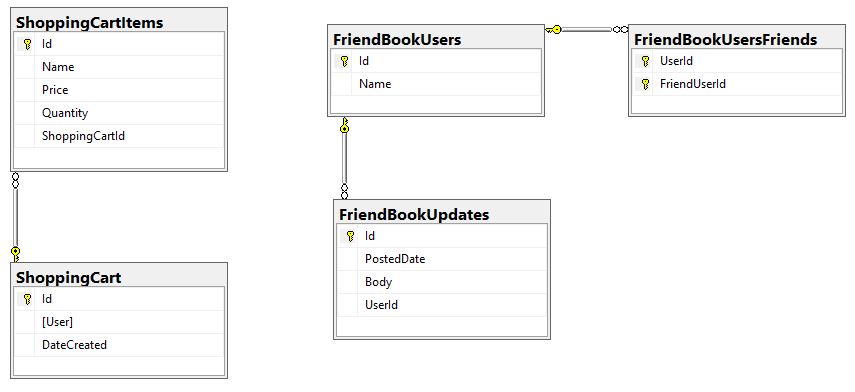
In my example, I said that a Shopping Cart - to - Shopping Cart Items relationship in a relational database would probably be better represented in JSON by a single Shopping Cart document (which contains Items). This is the "denormalization" path. Then, I suggested that a Social Media User - to - Social Media User Update relationship would be best represented in JSON with a referential relationship: updates live in their own documents, separate from the user.
This was an entirely manual process. For that simple example, it was not difficult. But with larger models, it would be helpful to have some tooling to assist in the SQL to JSON data modeling. It won’t be completely automatic: there’s still some art to it, but the tooling can do a lot of the work for us.
Starting with a SQL Server DDL
This next part assumes you’ve already run the SQL scripts to create the 5 tables: ShoppingCartItems, ShoppingCart, FriendBookUsers, FriendBookUpdates, and FriendBookUsersFriends. (Feel free to try this on your own databases, of course).
The first step is to create a DDL script of your schema. You can do this with SQL Server Management Studio.
First, right click on the database you want. Then, go to "Tasks" then "Generate Scripts". Next, you will see a wizard. You can pretty much just click "Next" on each step, but if you’ve never done this before you may want to read the instructions of each step so you understand what’s going on.
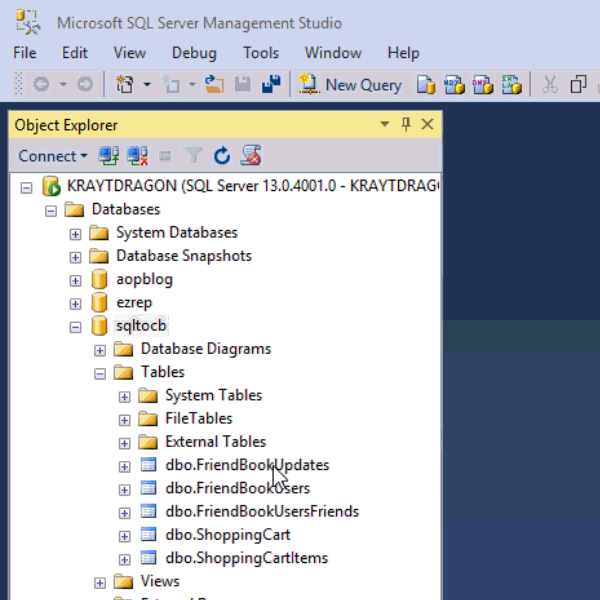
Finally, you will have a SQL file generated at the path you specified.
This will be a text file with a series of CREATE and ALTER statements in it (at least). Here’s a brief excerpt of what I created (you can find the full version on Github).
CREATE TABLE [dbo].[FriendBookUpdates](
[Id] [uniqueidentifier] NOT NULL,
[PostedDate] [datetime] NOT NULL,
[Body] [nvarchar](256) NOT NULL,
[UserId] [uniqueidentifier] NOT NULL,
CONSTRAINT [PK_FriendBookUpdates] PRIMARY KEY CLUSTERED
(
[Id] ASC
)WITH (PAD_INDEX = OFF, STATISTICS_NORECOMPUTE = OFF, IGNORE_DUP_KEY = OFF, ALLOW_ROW_LOCKS = ON, ALLOW_PAGE_LOCKS = ON) ON [PRIMARY]
) ON [PRIMARY]
GO
-- etc...By the way, this should also work with SQL Azure databases.
Note: Hackolade works with other types of DDLs too, not just SQL Server, but also Oracle and MySQL.
Enter Hackolade
This next part assumes that you have downloaded and installed Hackolade. This feature is only available on the Professional edition of Hackolade, but there is a 30-day free trial available.
Once you have a DDL file created, you can open Hackolade.
In Hackolade, you will be creating/editing models that correspond to JSON models: Couchbase (of course) as well as DynamoDB and MongoDB. For this example, I’m going to create a new Couchbase model.
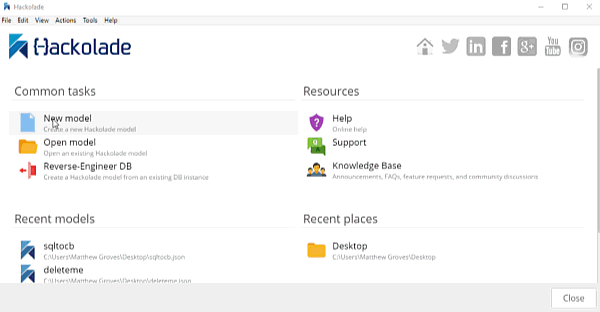
At this point, you have a brand new model that contains a "New Bucket". You can use Hackolade as a designing tool to visually represent the kinds of documents you are going to put in the bucket, the relationships to other documents, and so on.
We already have a relational model and a SQL Server DDL file, so let’s see what Hackolade can do with it.
Reverse engineer SQL to JSON data modeling
In Hackolade, go to Tools → Reverse Engineer → Data Definition Language file. You will be prompted to select a database type and a DDL file location. I’ll select "MS SQL Server" and the "script.sql" file from earlier. Finally, I’ll hit "Ok" to let Hackolade do its magic.

Hackolade will process the 5 tables into 5 different kinds of documents. So, what you end up with is very much like a literal translation.
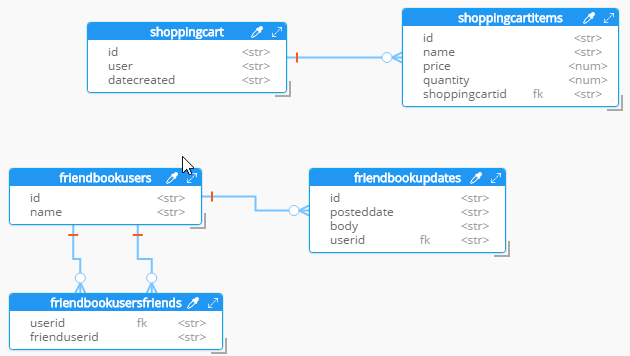
This diagram gives you a view of your model. But now you can think of it as a canvas to construct your ultimate JSON model. Hackolade gives you some tools to help.
Denormalization
For instance, Hackolade can make suggestions about denormalization when doing SQL to JSON data modeling. Go to Tools→Suggest denormalization. You’ll see a list of document kinds in "Table selection". Try selecting "shoppingcart" and "shoppingcartitems". Then, in the "Parameters" section, choose "Array in parent".
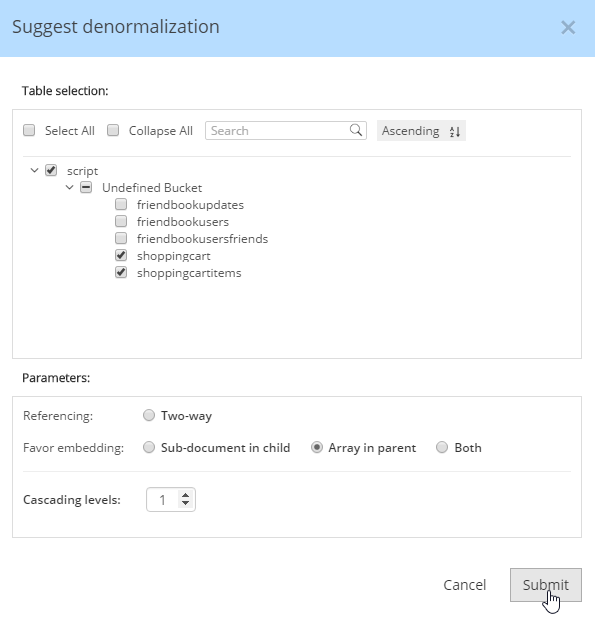
After you do this, you will see that the diagram looks different. Now, the items are embedded into an array in shoppingcart, and there are dashed lines going to shoppingcartitems. At this point, we can remove shoppingcartitems from the model (in some cases you may want to leave it, that’s why Hackolade doesn’t remove it automatically when doing SQL to JSON data modeling).
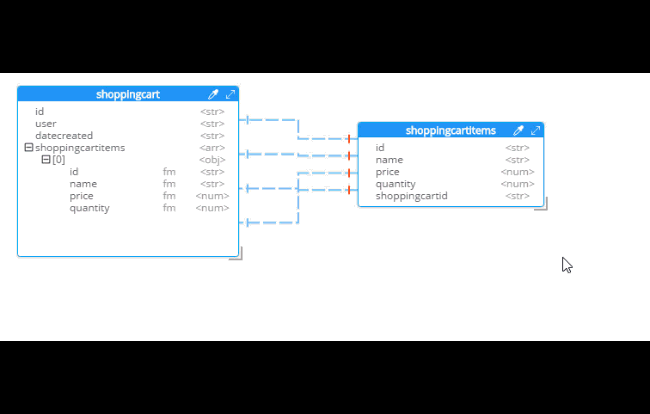
Notice that there are other options here too:
Embedding Array in parent - This is what was demonstrated above.
Embedding Sub-document in child - If you want to model the opposite way (e.g. store the shopping cart within the shopping cart item).
Embedding Both - Both array in parent and sub-document approach.
Two-way referencing - Represent a many-to-many relationship. In relational tables, this is typically done with a "junction table" or "mapping table"
Also note cascading. This is to prevent circular referencing where there can be a parent, child, grandchild, and so on. You select how far you want to cascade.
More cleanup
There are a couple of other things that I can do to clean up this model.
Add a 'type' field. In Couchbase, we might need to distinguish shoppingcart documents from other documents. One way to do this is to add a "discriminator" field, usually called 'type' (but you can call it whatever you like). I can give it a "default" value in Hackolade of "shoppingcart".
Remove the 'id' field from the embedded array. The SQL table needed this field for a foreign key relationship. Since it’s all embedded into a single document, we no longer need this field.
Change the array name to 'items'. Again, since a shopping cart is now consolidated into a single document, we don’t need to call it 'shoppingcartitems'. Just 'items' will do fine.

Output
A model like this can be a living document that your team works on. Hackolade models are themselves stored as JSON documents. You can share with team members, check them into source control, and so on.
You can also use Hackolade to generate static documentation about the model. This documentation can then be used to guide the development and architecture of your application.
Go to File → Generate Documentation → HTML/PDF. You can choose what components to include in your documentation.
SQL to JSON Data Modeling with Hackolade的更多相关文章
- MS SQL OPENJSON JSON
前段时间,有写过一个小练习<MS SQL读取JSON数据>https://www.cnblogs.com/insus/p/10911739.html 晚上为一个网友的问题,尝试获取较深层节 ...
- directly receive json data from javascript in mvc
if you send json data to mvc,how can you receive them and parse them more simply? you can do it like ...
- Guzzle Unable to parse JSON data: JSON_ERROR_SYNTAX - Syntax error, malformed JSON
项目更新到正式平台时,出现Guzzle(5.3) client get请求出现:Unable to parse JSON data: JSON_ERROR_SYNTAX - Syntax error, ...
- sql System.Data.SqlClient.SqlError: 无法覆盖文件 'C:\Program Files\Microsoft SQL Server\MSSQL\data\itsm_Data.MDF'。数据库 'my1' 正在使用该文件的解决方案
对数据库备份进行还原时遇到“sql System.Data.SqlClient.SqlError: 无法覆盖文件 'C:\Program Files\Microsoft SQL Server\MSSQ ...
- SQL*Net more data to client
The server process is sending more data/messages to the client. The previous operation to the client ...
- SQL*Net more data from client
SQL*Net more data from client The server is waiting on the client to send more data to its client sh ...
- 奇葩的SQL*Net more data from client等待,导致批处理巨慢
<pre name="code" class="sql"><pre name="code" class="sql ...
- 一个session已经ACTIVE20多小时,等待事件SQL*Net more data from client
问题描述: 一个session已经ACTIVE20多小时,等待事件SQL*Net more data from client 有一人session,从昨天上午11点多登陆(v$session.logi ...
- iReport 5.6.0 Error: net.sf.jasperreports.engine.JRException: Error executing SQL statement for : data 最优解决方案
问题描述 近期学习iReport(个人使用的是最新版本的 iReport-5.6.0,MySQL是 5.5.56版本),遇到一些问题,在安装完成后,创建了数据库,配置了MySQL数据库连接信息,新建报 ...
随机推荐
- [Micropython]TPYBoard v202 利用单片机快速实现家庭智能控制平台
一提到智能家庭,大家可能首先想到的是各种大佬级公司搞的牛逼产品,或者说是创新产品.想想就觉得很复杂,有的用工控机,有的用树莓派,还有的用arduino,不管用什么,都绕不过服务器进行控制,比如yeel ...
- Vue2.x源码学习笔记-Vue实例的属性和方法整理
还是先从浏览器直观的感受下实例属性和方法. 实例属性: 对应解释如下: vm._uid // 自增的id vm._isVue // 标示是vue对象,避免被observe vm._renderProx ...
- HTML5学习总结-番外05 http 状态码
所有状态码汇总: 1xx(临时响应)表示临时响应并需要请求者继续执行操作的状态代码. 代码 说明100 (继续) 请求者应当继续提出请求. 服务器返回此代码表示已收到请求的第一部分,正在等待其 ...
- 性能调优2:CPU
关系型数据库严重依赖底层的硬件资源,CPU是服务器的大脑,当CPU开销很高时,内存和硬盘系统都会产生不必需要的压力.CPU的性能问题,直观来看,就是任务管理器中看到的CPU利用率始终处于100%,而侦 ...
- 序列化与ArrayList 的elementData的修饰关键字transient
transient用来表示一个域不是该对象序行化的一部分,当一个对象被序行化的时候,transient修饰的变量不会被序列化 ArrayList的动态数组elementData被transient ...
- ASP.NET MVC5+EF6+EasyUI 后台管理系统(92)-打印EasyUI 的datagrid表格
前言 应用系统有时候需要打印Datagrid的表格内容,我们本节就来学习打印datagrid内容 打印主要使用:web打印(我们之前有讲过web打印插件jqprint) + 将datagrid重新编制 ...
- ASP.NET MVC5+EF6+EasyUI 后台管理系统(90)-EF 扩展操作
上一篇讲了EF直接执行SQL与存储过程的用 法 这次我们来看 EntityFramework-Plus(免费开源) 库的用法相比其他扩展库,这个更加新并且用法更加简单 这是一个对Entity Fram ...
- Jmeter(三十八)while控制器实现ssh三次重连
在jmeter中,可以使用SSH协议连接主机进行相关操作, 步骤如下 首先添加一个ssh command 我们的测试交流群:317765580 在command中填写远程连接的必要信息 结果树中可以 ...
- 使用 OpenSSL 创建私有 CA:1 根证书
OpenSSL 创建私有 CA 三部曲:使用 OpenSSL 创建私有 CA:1 根证书使用 OpenSSL 创建私有 CA:2 中间证书使用 OpenSSL 创建私有 CA:3 用户证书 OpenS ...
- 007-迅雷定时重启AutoHotkey脚本-20190411
;; 定时重启迅雷.ahk,;;~ 2019年04月11日;#SingleInstance,forceSetWorkingDir,%A_ScriptDir%DetectHiddenWindows,On ...
